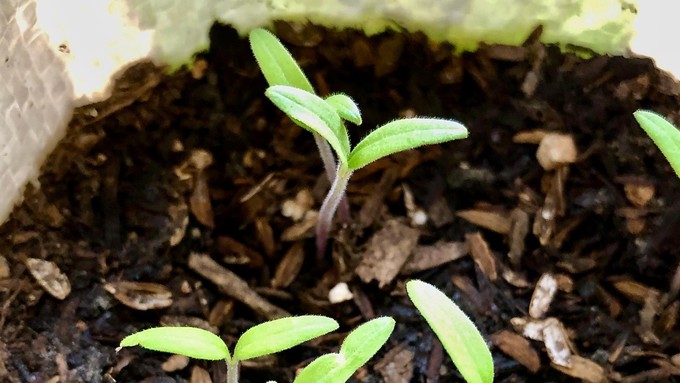
Learn how to grow more -- and save more, too

How to get seeds to this point -- and then keep them growing -- is the focus of free workshops at four of the Green Acres nurseries this Saturday. Kathy Morrison
Spring (and summer) may be months away, but it’s time to start planning – and planting.
Growing food and flowers from seed can make gardening (and eating) much more budget-friendly. Get tips galore this Saturday, Feb. 8, at free “Garden Talks,” hosted by Green Acres Nursery & Supply.
Set for 10 a.m. Saturday at four Green Acres locations, “Garden Talk: Seed Starting” will cover the basics of growing plants from seed.
Which plants are easiest to start from seed? When should they be planted? Indoors or outdoors? What kind of growing medium works best? How do you help those first sprouts thrive? Those are just a few of the questions Green Acres’ Garden Gurus will address.
No advance registration is necessary; just show up and prepare to take notes.
This Garden Talk will be presented at Green Acres in Elk Grove (9220 E. Stockton Blvd.), Folsom (205 Serpa Way ), Rocklin (5436 Crossings Drive) and Roseville (7300 Galilee Road).
Details and directions: https://idiggreenacres.com/
‘FIMBY’ debuts Tuesday
Growing food and other budget-conscious gardening are expected to be major trends in 2025. To help feed that growing interest, Sacramento Digs Gardening will launch a new weekly series, “Food in My Back Yard.”
FIMBY will appear on Tuesdays both online and in our e-newsletter. It will focus on tips for success, pests, common issues and much more. Got a question or suggested topic? Email us at sacdigsgardening@gmail.com.
FIMBY starts Tuesday, Feb. 4, and we’re kicking off with the same logical beginning: Seed starting! (Great gardeners do think alike!)
Kathy Morrison, our SDG co-creator and Sacramento County master gardener, over the years has started hundreds of tomato and pepper plants, plus herbs and other vegetables, each year from seed. Find out her advice on how to get seeds off to a healthy start.
Follow FIMBY every Tuesday at https://sacdigsgardening.californialocal.com/
Comments
0 comments have been posted.Sacramento Digs Gardening to your inbox.
Food in My Back Yard Series
May 6: Maintain soil moisture with mulch for garden success
April 29: What's (already) wrong with my tomato plants?
April 22: Should you stock up on fertilizer? (Yes!)
April 15: Grow culinary herbs in containers
April 8: When to plant summer vegetables
April 1: Don't be fooled by these garden myths
March 25: Fertilizer tips: How to 'feed' your vegetables for healthy growth
March 18: Time to give vegetable seedlings some more space
March 11: Ways to win the fight against weeds
March 4: Potatoes from the garden
Feb. 25: Plant a fruit tree now -- for later
Feb. 18: How to squeeze more food into less space
Feb. 11: When to plant? Consider staggering your transplants
Feb. 4: Starting in seed starting
Sites We Like
Garden Checklist for week of May 11
Make the most of the lower temperatures early in the week. We’ll be back in the 80s by Thursday.
* Plant, plant, plant! It’s prime planting season in the Sacramento area. Time to set out those tomato transplants along with peppers and eggplants. Pinch off any flowers on new transplants to make them concentrate on establishing roots instead of setting premature fruit.
* Direct-seed melons, cucumbers, summer squash, corn, radishes, pumpkins and annual herbs such as basil.
* Harvest cabbage, lettuce, peas and green onions.
* In the flower garden, direct-seed sunflowers, cosmos, salvia, zinnias, marigolds, celosia and asters. (You also can transplant seedlings for many of the same flowers.)
* Plant dahlia tubers.
* Transplant petunias, marigolds and perennial flowers such as astilbe, columbine, coneflowers, coreopsis, dahlias, rudbeckia and verbena.
* Keep an eye out for slugs, snails, earwigs and aphids that want to dine on tender new growth.
* Feed summer bloomers with a balanced fertilizer.
* For continued bloom, cut off spent flowers on roses as well as other flowering plants.
* Add mulch to the garden to maintain moisture. Mulch also cuts down on weeds. But don’t let it mound around the stems or trunks of trees or shrubs. Leave about a 6-inch-to-1-foot circle to avoid crown rot or other problems.
* Remember to weed! Pull those nasties before they set seed.
* Water early in the day and keep seedlings evenly moist.